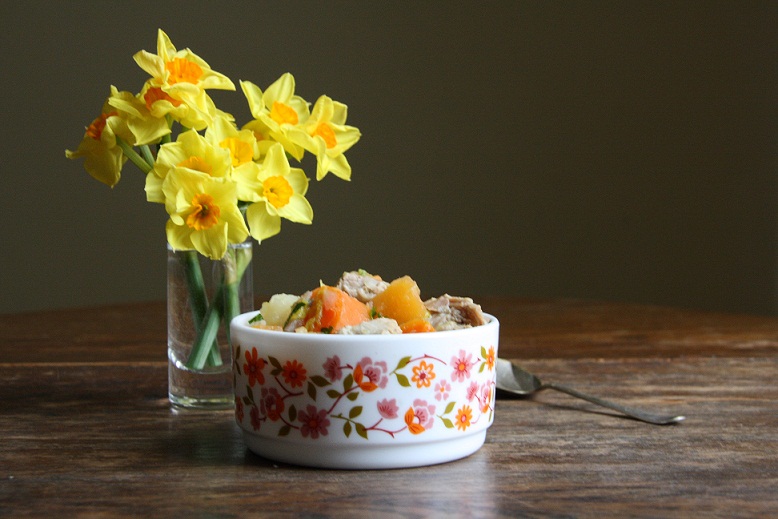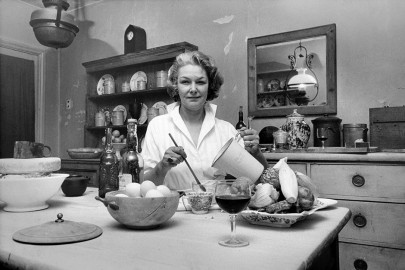March 1st: a day to pin a daffodil or leek to your lapel, sing a ballad or two and generally celebrate being Welsh (if you are Welsh. If you aren’t, you may look a little ridiculous, although good for you for carrying on with multiculturalism when it’s so unfashionable).
The 1st of March is the day St David died, having reached the ripe old age of 142 (or 147, depending on your sources). Clearly his ascetic lifestyle and vegetarian diet served him well. Bread, herbs, vegetables, water and a little salt were the dishes of the day in the monasteries he founded, where the rations proved so popular a cabal of monks attempted to poison him. Luckily for David, St Scuthyn had got wind of this plot and rode from Ireland on the back of a sea monster to warn him. St David blessed the murderous bread and ate it without suffering so much as a stomachache.
Given his vegetarianism, celebrating St David’s Day with a lamb stew seems a little disrespectful. A cawl cennin – leek broth – would be more appropriate, but having just honoured Robert Burns with a cock-a-leekie soup, another allium-heavy meal is unappealing. Instead, I’m raising a bowl of classic, meaty cawl to the memory of Wales’ patron saint.
Cawl can be best described as a muddle of cheap cuts of meat and seasonal vegetables. Like most workingman’s fare, the ingredients list depends on what you’ve got rather than prescribing what you should go out and buy. Lamb tends to be the meat of choice these days, but mutton, beef, bacon or pork can all be used without being considered heresy. As long as it’s cheap, on the bone and benefits from long, slow cooking, it’s a good choice.
It takes a few hours to make and simmering the basic soup stock a day ahead means you can let it cool and scoop off the fat before moving on to make the cawl itself. It’s extremely hearty and if the arrival of March doesn’t quite mark the arrival of Spring, then a substantial bowl of cawl will help to keep the cold at bay.
Cawl
Serves 4-6
800g–1kg shoulder of lamb on the bone
A couple of black peppercorns
2 litres water
1 onion, peeled and chopped
3 large carrots, peeled and thickly sliced
500g swede, peeled and roughly chopped
2 large potatoes, peeled and roughly chopped
2 leeks, trimmed and sliced
A handful of fresh parsley leaves, chopped, to serve
1. Remove any large, obvious pieces of fat from the lamb shoulder. Place the lamb and peppercorns in a large pan with the water and a pinch of salt. Cover and bring to the boil. Reduce the heat and simmer for 1 hour.
2. Leave to go cold and then skim off any fat and scum that has risen to the surface. Fish out the peppercorns if you spot them. Pull the lamb off the bone and return to the stock, discarding the bone.
3. Bring the stock back to a simmer and add the onion, carrots, swede, potatoes and leeks. Simmer, covered, for approximately 1 hour 30 minutes. The lamb should be tender and the vegetables on the cusp of collapsing.
4. Stir in a large handful of fresh parsley and adjust the seasoning to taste. Ladle into warm bowls and serve straight away.











I’m going to give this recipe to my wife, as she is currently having a lamb phase!
I was brought up on cawl – winter Saturday lunchtimes, usually before playing or watching rugby. I imagine there are as many recipes for cawl as there are Welsh mams (though, keep it quiet, but my Dad makes the best ones).
For what it’s worth, in our house we boiled the meat until it fell off the bone, added chopped leeks and split peas early on (so they mostly disintegrated, thickening and flavouring it), and stuck in a few suet dumplings at the end. Also, if warranted, a sprinkling of flour would be applied to any fat that had risen to the surface – this would be thickened by letting it steam with the lid on. It stuck to your ribs – you had to go easy if you were playing later in the day.
I make it myself sometimes – I believe the key to achieving a really rich flavour and a truly nourishing consistency is simmering the meat on the bone for a few hours (neck of lamb is best as it’s tough, flavoursome and very cheap) and using the leeks and split peas as described.
By the way, as so often in life, the insertion of a parsnip can work wonders – it gives an extra dimension of flavour and imparts a silky unctuousness if left to go soft.
as so often in life, the insertion of a parsnip can work wonders
Immortal, Gaw.
I was going to make it with neck of lamb, but there was a shortage when I went shopping so shoulder it was. Your recipe sounds like a proper rib-sticker. And who doesn’t enjoy the insertion of a parsnip? Always a delight.
My problem with cawl – even the veggie-friendly leek version – is that the word sounds too much like ‘caul’. What about this, though? The little song that goes with it is hilarious, although whether that was the original intention is another question altogether.
Like many Welsh dishes (Welsh cakes, Welsh rarebit) it looks like these could be cooked on a hot stone in the hearth. My Taid used to replicate old-style Welsh cooking by melting his cheese on a tray in the oven and then spreading it on bread.